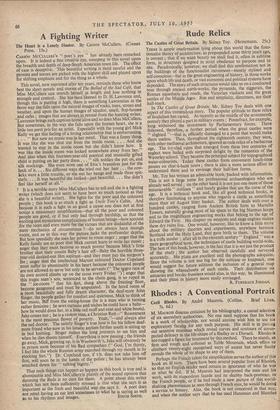Rude Relics
The Castles of Great Britain. By Sidney Toy. (Heinemann. 25s.)
THERE is ample confirmation lying about this world that the func- tionalist theory of architecture, as propounded some thirty years ago, is correct ; that if we want beauty we shall find it, often in sublime form, in structures designed in strict obedience to purpose and to site. Paradoxically, however, we shall find this confirmation not in the buildings of the functionalist movement—mostly stylised and self-conscious—but in the great engineering of history, in those works upon which life and death, or vast economic and political systems have depended. The story of such structures would take us on a conducted tour through ancient earth-works, the pyramids, the ziggurats, the Roman aqueducts and roads, the Victorian viaducts and the great castles of the Middle Ages. Size and simplicity, directness, are their hall-mark.
In The Castles of Great Britain, Mr. Sidney Toy deals with one aspect of this tremendous story. The popular attitude to these relics of feudalism has varied. As recently as the middle of the seventeenth cent* they played a part in military events ; Pontefract, for example, long withstood the investment by Parliamentary forces. There followed, therefore, a further period when the great castles were " slighted "—that is, officially damaged to a point that would make them useless. Then, throughout the eighteenth century, they were, with other mediaeval architecture, ignored as rude relics of a barbarous age. The ivy-clad ruins that emerged from these two centuries of neglect were hailed with surprised delight by the romantics of the Waverley school. They became the principal subject for topographical water-colourists. Today these castles form convenient lunch-time pauses on char-a-bane tours ; there is also a more serious effort to understand them and to envisage their half-lost forms.
Mr. Toy has written an admirable book, packed with information. This is not a large tome for professional archaeologists who are already well served ; on the other hand it is not just one more of those innumerable " outlines " and handy guides that are the curse of the age. It is a technical book and, like all good technical books, is therefore fascinating to anyone who regards a castle as something more than an August litter basket. The author deals with over a hundred castles, ranging from Ancient British forts to Martello Towers, naturally giving most of his space to the big Norman keeps and to the magnificent engineering works that belong to the age of Edward the First. His chapter on weapons and siege engines makes these dry ruins live. One would, however, like to know a little more about the military theories and experiments, anywhere between Scotland and the Holy Land, that gave birth to them. The volume is a trifle insular ; after all in the eleventh century " England " was a mere geographical term, the techniques of castle building world-wide. The best of this book, however, is the fact that it is not just the product of the study ; the author has observed carefully and surveyed accurately. His plans are excellent and the photographs adequate. Since the volume is not too big for the suitcase or knapsack, one would suggest for future editions the inclusion of a general map showing the whereabouts of each castle. Their distribution on estuaries and border frontiers would also, in this way, be illuminated and their place in history more easily envisaged.
R. FURNEAUX JORDAN.


































 Previous page
Previous page